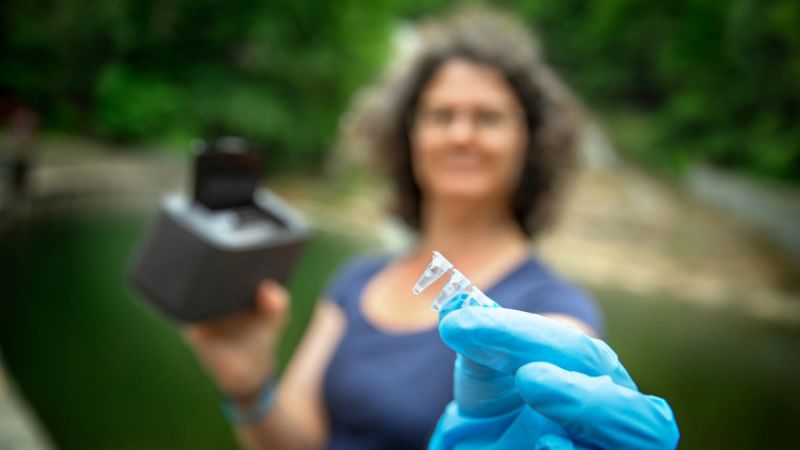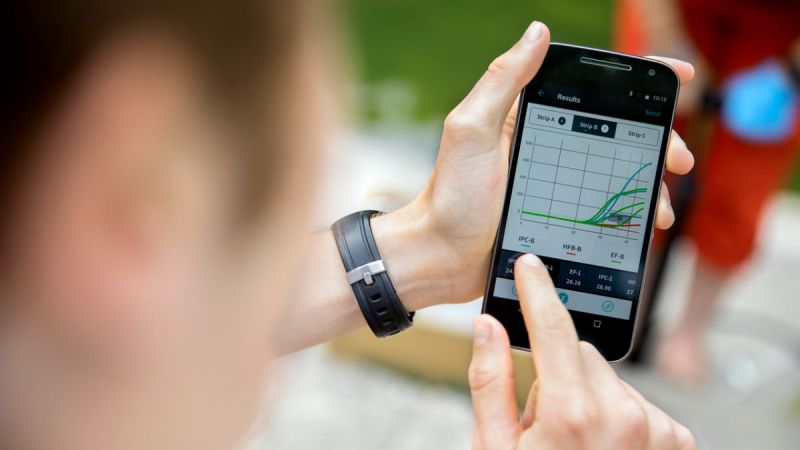Engineers Test Device for Monitoring NY State Park Water Quality
Published on by Water Network Research, Official research team of The Water Network in Technology
Cornell University professor and her students are testing a new water monitoring technology that, if approved by New York state and federal authorities, could drastically reduce the time state park swim areas must close when water is suspected of being unswimmable.
By Tom Fleischman

Ruth Richardson, associate professor of civil and environmental engineering, holds water samples to be inserted into the Biomeme device. Lindsay France/University Photography, Via Cornell Chronicle
It’s a beautiful mid-June Tuesday morning, and Ruth Richardson, associate professor of civil and environmental engineering, is at the swim beach at Buttermilk Falls State Park with a few students, enjoying the reward for surviving a seemingly endless Ithaca winter.
But no, the group is not swimming – they are testing a new water monitoring technology that, if approved by New York state and federal authorities, could drastically reduce the time state park swim areas must close when water is suspected of being unswimmable.
How drastic a reduction? From 24-30 hours down to 90 minutes or less.
“We were really excited to hear about the scope of [Richardson’s] work and what it could mean. The implications for parks would be pretty great,” said James Brophy, Buttermilk Falls park manager.
A chance meeting with a former graduate student led to Richardson connecting with Biomeme Inc., a Philadelphia, Pennsylvania-based biotechnology device maker. Richardson and her group are testing Biomeme’s DNA detector, the two3TM, for possible use as a rapid water-testing device for state park swim beaches.
The device checks for fecal indicator bacteria, which aren’t themselves pathogens but could indicate the presence of any of a number of pathogens. The ones Richardson is interested in are those that affect that gastrointestinal tract.
“We go and sample the water and process it right there in the park,” said Richardson, who is also a fellow at the Atkinson Center for a Sustainable Future. “And 45 minutes later, the machine will give you an answer. Start to finish, it’s approximately an hour to your answer, so you could have relevant information before you open the beach.”
In addition to Buttermilk Falls, Richardson and her students have been conducting tests at Robert H. Treman State Park in Ithaca, and they are planning trips to Long Island and to western New York to conduct remote field testing of the Biomeme device.
The two3 device – a quantitative polymerase chain reaction (qPCR) thermocycler – detects and amplifies DNA. Water is filtered and prepped in three tubes, then runs through the device. Information is sent via an iPhone – included with the device, which runs nearly $4,000 – to a cloud portal, and can also be monitored in real time. Test results are available in less than an hour.
Perfect application
The Biomeme device wasn’t designed specifically for swim water testing, but Richardson thought it would be a perfect application, so she contacted the state Environmental Management Bureau in Albany. Richardson saw it as a solution to a frequent inconvenience at many of New York’s 64 state parks with swim beaches: closure of beaches due to water quality.
According to Brophy, the state conducts weekly testing of water at all of its swim areas. Water samples are sent off to a lab, which then conducts analysis; the minimum time before the park has an answer regarding water quality is 24 hours, though it often is more, Brophy said. And if after 24 hours there’s another positive E. coli test, the 24-hour clock starts all over again.

Nate Barott '20 checks data collected from the Biomeme PCR thermocycler, which can determine the level of fecal indicator bacteria in a water sample in 60 to 90 minutes. Lindsay France/University Photography, Via Cornell Chronicle
Beaches close before test results are announced if there is a predicted exceedance of E. coli colonies (more than 235 per 100 ml), due either to environmental conditions or more than 0.7 inches of rain in a 24-hour period, which can lead to fouling due to runoff. “We are always going to err on the side of caution,” Brophy said.
A big goal for this summertime project, Richardson said, is validation of her quick-test system.
“The beaches are still doing their normal sampling and bacteria analysis, they send it away to a lab for testing – that’s the gold standard, even though it’s antiquated,” Richardson said. “And so we’re going to be right next to them getting water samples, and seeing what results we get and to see whether they agree.”
In concert with the Biomeme device, Richardson is using a device she developed, the PathogenPanel, to test directly for 12 specific pathogens of interest. Water samples are dispensed onto 48 tiny panels, then sent to a lab at the College of Veterinary Medicine for analysis.
“We get a lot of information from these panels,” she said. “Definitely it’s the pathogens that are most important, but we also get some other information that might help if someone is saying, ‘How do we correct it if we keep on having these high levels?’ In order to mitigate that problem, you have to know where it’s coming from.”
Currently, the Biomeme device is not approved by the Food and Drug Administration and is for research only, according to the company’s website. If Richardson’s testing goes well, the next step could be more parallel testing with current methods to further validate the Biomeme device’s effectiveness.
Richardson ran a pilot test last fall, then secured funding from the Cornell-based New York State Water Resources Institute and the U.S. Geological Survey to conduct more testing this summer. “Two small pots of money for one broad project,” she said, noting that the Atkinson Center’s Academic Venture Fund supported early studies in this area.
It’s a project that could have a major impact on summer fun in New York state, a fact that’s appealing to team member Cristina Fernandez-Baca, Ph.D. ’18.
“Recreational waters are super-important and everybody enjoys them,” she said, “so what we’re doing is important.”
Source: Cornell Chronicle
Media
Taxonomy
- Technology
- Water Monitoring
- Water Monitoring
- Monitoring & Control
- Water Quality Monitoring
- Water Software
- Monitoring Technology
- Remote Monitoring & Control